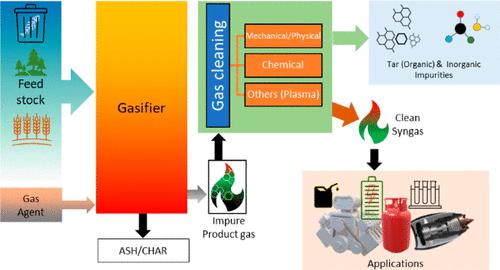Our official English website, www.x-mol.net, welcomes your
feedback! (Note: you will need to create a separate account there.)
Tar Formation in Gasification Systems: A Holistic Review of Remediation Approaches and Removal Methods
ACS Omega ( IF 3.7 ) Pub Date : 2024-01-04 , DOI: 10.1021/acsomega.3c04425
Ananthanarasimhan Jayanarasimhan 1 , Ram Mohan Pathak 1 , Anand M Shivapuji 1 , Lakshminarayana Rao 1
ACS Omega ( IF 3.7 ) Pub Date : 2024-01-04 , DOI: 10.1021/acsomega.3c04425
Ananthanarasimhan Jayanarasimhan 1 , Ram Mohan Pathak 1 , Anand M Shivapuji 1 , Lakshminarayana Rao 1
Affiliation

|
Gasification is an advanced thermochemical process that converts carbonaceous feedstock into syngas, a mixture of hydrogen, carbon monoxide, and other gases. However, the presence of tar in syngas, which is composed of higher molecular weight aromatic hydrocarbons, poses significant challenges for the downstream utilization of syngas. This Review offers a comprehensive overview of tar from gasification, encompassing gasifier chemistry and configuration that notably impact tar formation during gasification. It explores the concentration and composition of tar in the syngas and the purity of syngas required for the applications. Various tar removal methods are discussed, including mechanical, chemical/catalytic, and plasma technologies. The Review provides insights into the strengths, limitations, and challenges associated with each tar removal method. It also highlights the importance of integrating multiple techniques to enhance the tar removal efficiency and syngas quality. The selection of an appropriate tar removal strategy depends on factors such as tar composition, gasifier operating and design factors, economic considerations, and the extent of purity required at the downstream application. Future research should focus on developing cleaning strategies that consume less energy and cause a smaller environmental impact.
中文翻译:

气化系统中焦油的形成:修复方法和去除方法的全面审查
气化是一种先进的热化学过程,可将碳质原料转化为合成气(氢气、一氧化碳和其他气体的混合物)。然而,合成气中焦油的存在(由较高分子量的芳烃组成)给合成气的下游利用带来了重大挑战。本综述对气化焦油进行了全面概述,包括对气化过程中焦油形成有显着影响的气化炉化学和配置。它探讨了合成气中焦油的浓度和组成以及应用所需的合成气纯度。讨论了各种焦油去除方法,包括机械、化学/催化和等离子体技术。该评论深入了解了每种焦油去除方法的优点、局限性和挑战。它还强调了整合多种技术以提高焦油去除效率和合成气质量的重要性。选择合适的焦油去除策略取决于焦油成分、气化器操作和设计因素、经济考虑以及下游应用所需的纯度等因素。未来的研究应侧重于开发消耗更少能源并对环境影响更小的清洁策略。
更新日期:2024-01-04
中文翻译:

气化系统中焦油的形成:修复方法和去除方法的全面审查
气化是一种先进的热化学过程,可将碳质原料转化为合成气(氢气、一氧化碳和其他气体的混合物)。然而,合成气中焦油的存在(由较高分子量的芳烃组成)给合成气的下游利用带来了重大挑战。本综述对气化焦油进行了全面概述,包括对气化过程中焦油形成有显着影响的气化炉化学和配置。它探讨了合成气中焦油的浓度和组成以及应用所需的合成气纯度。讨论了各种焦油去除方法,包括机械、化学/催化和等离子体技术。该评论深入了解了每种焦油去除方法的优点、局限性和挑战。它还强调了整合多种技术以提高焦油去除效率和合成气质量的重要性。选择合适的焦油去除策略取决于焦油成分、气化器操作和设计因素、经济考虑以及下游应用所需的纯度等因素。未来的研究应侧重于开发消耗更少能源并对环境影响更小的清洁策略。































 京公网安备 11010802027423号
京公网安备 11010802027423号